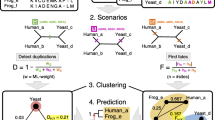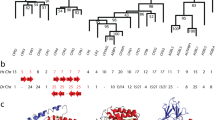Abstract.
The trypsin family of serine proteases is one of the most studied protein families, with a wealth of amino acid sequence information available in public databases. Since trypsin-like enzymes are widely distributed in living organisms in nature, likely evolutionary scenarios have been proposed. A novel methodology for Fourier transformation of biological sequences (FOTOBIS) is presented. The methodology is well suited for the identification of the size and extent of short repeats in protein sequences. In the present paper the trypsin family of enzymes is analyzed with FOTOBIS and strong evidence for tandem gene duplication is found. A likely evolutionary path for the development of present-day trypsins involved an intrinsic extensive tandem gene duplication of a small DNA fragment of 15–18 nucleotides, corresponding to five or six amino acids. This ancestral trypsin gene was subsequently duplicated, leading to the earliest version of a full-sized trypsin, from which the contemporary trypsins have developed.
Similar content being viewed by others
Author information
Authors and Affiliations
Additional information
Received: 22 November 1997 / Accepted: 26 January 1998
Rights and permissions
About this article
Cite this article
Baptista, A., Jonson, P., Hough, E. et al. The Origin of Trypsin: Evidence for Multiple Gene Duplications in Trypsins. J Mol Evol 47, 353–362 (1998). https://doi.org/10.1007/PL00006393
Issue Date:
DOI: https://doi.org/10.1007/PL00006393




